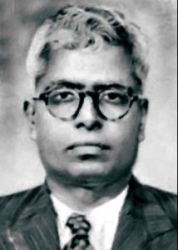| Subbayya Sivasankaranarayana Pillai | |
|---|---|
 | |
| Born | 5 April 1901 Vallam, British India (now in Tamil Nadu, India) |
| Died | 31 August 1950 (1950-09-01) (aged 49) Cairo, Egypt |
| Nationality | Indian |
| Alma mater | Scott Christian College, Nagercoil |
| Known for | |
| Scientific career | |
| Fields | Mathematics |
Subbayya Sivasankaranarayana Pillai (5 April 1901 – 31 August 1950) was an Indian mathematician specialising in number theory. His contribution to Waring's problem was described in 1950 by K. S. Chandrasekharan as "almost certainly his best piece of work and one of the very best achievements in Indian Mathematics since Ramanujan".
Biography
Subbayya Sivasankaranarayana Pillai was born to parents Subbayya Pillai and Gomati Ammal. His mother died a year after his birth and his father when Pillai was in his last year at school.
Pillai did his intermediate course and B.Sc Mathematics in the Scott Christian College at Nagercoil and managed to earn a B.A. degree from Maharaja's college, Trivandrum.
In 1927, Pillai was awarded a research fellowship at the University of Madras to work among professors K. Ananda Rau and Ramaswamy S. Vaidyanathaswamy. He was from 1929 to 1941 at Annamalai University where he worked as a lecturer. It was in Annamalai University that he did his major work in Waring's problem. In 1941 he went to the University of Travancore and a year later to the University of Calcutta as a lecturer (where he was at the invitation of Friedrich Wilhelm Levi).
For his achievements he was invited in August 1950, for a year to visit the Institute for Advanced Study, Princeton, United States. He was also invited to participate in the International Congress of Mathematicians at Harvard University as a delegate of the Madras University but he died during the crash of TWA Flight 903 in Egypt on the way to the conference.
Contributions
He proved the Waring's problem for in 1935 under the further condition of ahead of Leonard Eugene Dickson who around the same time proved it for
He showed that where is the largest natural number and hence computed the precise value of .
The Pillai sequence 1, 4, 27, 1354, ..., is a quickly growing integer sequence in which each term is the sum of the previous term and a prime number whose following prime gap is larger than the previous term. It was studied by Pillai in connection with representing numbers as sums of prime numbers.
References
- ^ "An outstanding mathematician". The Hindu. Archived from the original on 28 September 2007. Retrieved 14 July 2013.
- ^ Uma Dasgupta (2011). Science and Modern India: An Institutional History, C. 1784–1947. Pearson Education India. pp. 702–. ISBN 978-81-317-2818-5. Retrieved 14 July 2013.
- Raghavan Narasimhan The coming of age of mathematics in India, in Michael Atiyah u.a. Miscellanea Mathematica, Springer Verlag 1991, S. 250f
- Alladi, Krishnaswami (2013). Ramanujan's Place in the World of Mathematics: Essays Providing a Comparative Study. Springer. pp. 42–. ISBN 978-81-322-0767-2. Retrieved 14 July 2013.
- ^ "S. S. Pillai". Archived from the original on 19 October 2009.
- Number Theory. Universities Press. 2003. pp. 95–. ISBN 978-81-7371-454-2. Retrieved 15 July 2013.
- Sloane, N. J. A. (ed.). "Sequence A066352 (Pillai sequence)". The On-Line Encyclopedia of Integer Sequences. OEIS Foundation.
- 1901 births
- 1950 deaths
- Scientists from Tamil Nadu
- People from Kanyakumari district
- 20th-century Indian mathematicians
- Indian number theorists
- Academic staff of the University of Calcutta
- Institute for Advanced Study visiting scholars
- Academic staff of the University of Madras
- Academic staff of Annamalai University
- Victims of aviation accidents or incidents in 1950
- Victims of aviation accidents or incidents in Egypt
- University of Calcutta alumni
 in 1935 under the further condition of
in 1935 under the further condition of  ahead of
ahead of 
 where
where  is the largest natural number
is the largest natural number  and hence computed the precise value of
and hence computed the precise value of  .
.